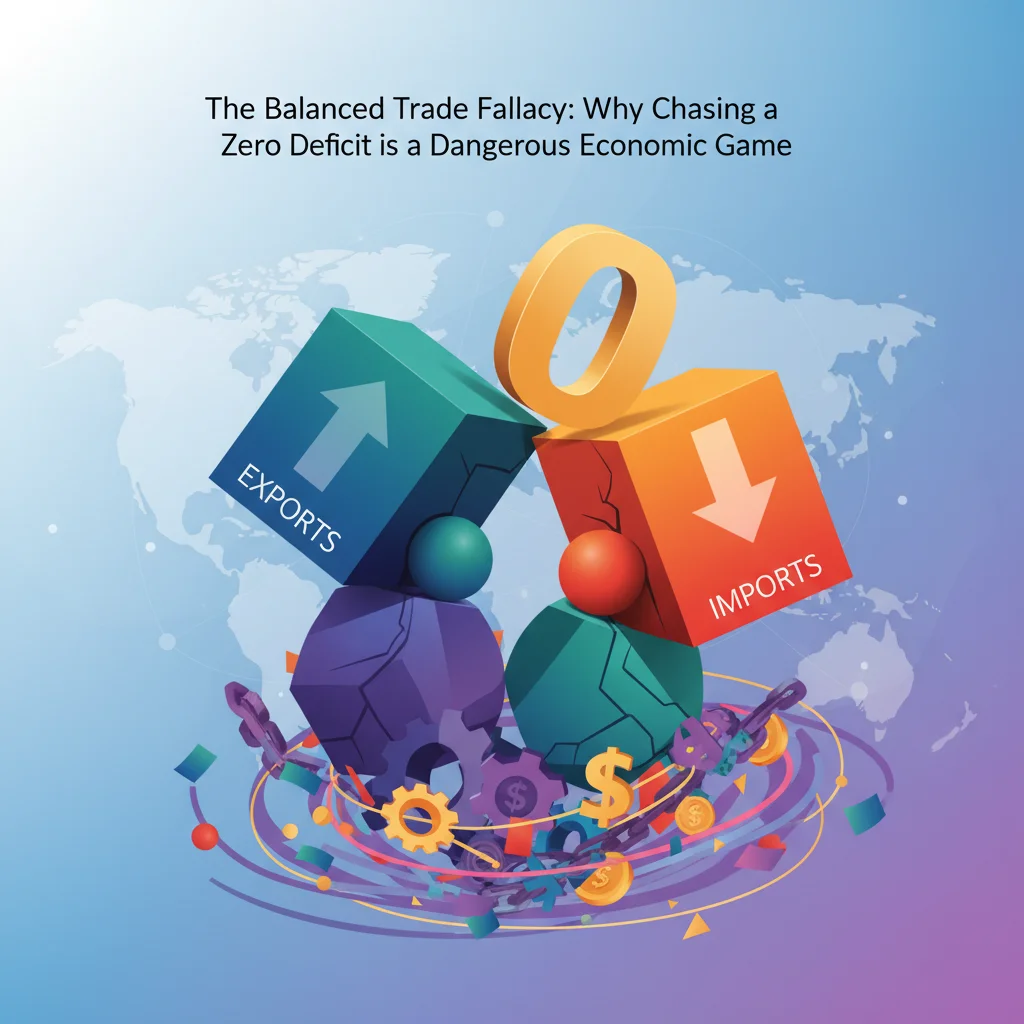
The Balanced Trade Fallacy: Why Chasing a Zero Deficit is a Dangerous Economic Game
In the high-stakes world of international finance and economics, few numbers are as misunderstood and politically charged as the trade deficit. We hear it discussed constantly as a scorecard for a nation’s economic strength—a high deficit is framed as a “loss,” while a surplus is a “win.” This simplistic view fuels calls for “balanced trade,” a seemingly common-sense goal where a country’s exports equal its imports. But what if this entire framework is dangerously flawed?
A recent letter in the Financial Times by Sanjay G Reddy, Professor of Economics at The New School for Social Research, highlights the “confusing prescription” often offered for achieving this balance. This critique serves as a crucial reminder for investors, business leaders, and anyone involved in the global economy: the pursuit of balanced trade is often based on a fundamental misunderstanding of how modern finance and trade actually work. It’s time to look beyond the headlines and deconstruct this pervasive economic myth.
What is ‘Balanced Trade’ and Why Are We So Obsessed?
At its core, the concept of a trade balance is straightforward. It’s the difference between the monetary value of a nation’s exports and imports over a specific period.
- Trade Surplus: Exports > Imports. The country sells more than it buys.
- Trade Deficit: Imports > Exports. The country buys more than it sells.
- Balanced Trade: Exports ≈ Imports.
The political appeal of balanced trade is rooted in a simple, yet misleading, household analogy. If a family consistently spends more than it earns, it’s heading for financial trouble. Politicians often apply this same logic to a country, painting a trade deficit as a sign of national profligacy and economic weakness. This narrative suggests that a nation with a trade deficit is “losing” jobs and wealth to other countries.
However, a national economy is infinitely more complex than a household budget. Unlike a family, a country can issue its own currency, and more importantly, its financial accounts have two sides. The obsession with the trade balance ignores its inseparable counterpart: the capital account. This is where the balanced trade argument begins to fall apart.
The Other Side of the Coin: Understanding the Balance of Payments
To truly understand international trade, we must look at the full picture—the Balance of Payments. This is an accounting record of all monetary transactions between a country and the rest of the world. It’s composed of two main parts: the Current Account and the Capital (or Financial) Account.
The Current Account primarily tracks the flow of goods and services (the trade balance), as well as income from foreign investments and transfers.
The Capital Account tracks the flow of investment capital. This includes foreign direct investment (e.g., a company building a factory), portfolio investment (e.g., buying stocks or bonds), and other financial transactions.
Here is the crucial, non-negotiable rule of international economics: these two accounts must always balance to zero. A deficit in one must be matched by a surplus in the other. Therefore, a current account (trade) deficit is, by definition, financed by a capital account surplus. This isn’t a theory; it’s an accounting identity (source).
A capital account surplus means that more foreign money is flowing into the country to purchase assets than domestic money is flowing out. Foreign investors are buying up the country’s stocks, bonds, real estate, and companies. So, a trade deficit isn’t a sign of money simply vanishing; it’s a sign that the country is a net recipient of global investment.
To clarify this distinction, consider the two competing narratives:
| The Simplistic “Balanced Trade” Narrative | The Economic Reality (Balance of Payments) |
|---|---|
| A trade deficit means the country is “losing” money. | A trade deficit (current account deficit) is offset by a capital account surplus. The books always balance. |
| It signifies a weak economy that can’t compete. | It often signifies an attractive investment destination, where global capital seeks higher returns. |
| The goal should be to reduce imports and boost exports to “fix” the number. | The goal should be to ensure the incoming capital is used for productive investment, not just consumption. |
The Dangerous Prescriptions for a “Cure”
As Professor Reddy’s letter implies, the policies prescribed to “fix” a trade deficit are often more damaging than the deficit itself. These protectionist measures, born from a misunderstanding of economics, can stifle growth and harm consumers.
1. Tariffs: A Tax on Everyone
The most common tool is the tariff—a tax on imported goods. The theory is that this will make foreign products more expensive, encouraging consumers to buy domestic alternatives. In reality, tariffs are a blunt instrument with severe side effects. They are often paid by domestic consumers in the form of higher prices and by domestic businesses that rely on imported materials. The risk of retaliatory tariffs from other nations is also high, leading to trade wars that harm everyone, especially a country’s own export industries.
2. Quotas: The Scarcity Solution
Import quotas are direct limits on the quantity of a specific good that can be imported. While they protect a domestic industry from competition, they do so by creating artificial scarcity. This leads to higher prices for consumers and less choice. It can also breed inefficiency in the protected industry, as it no longer needs to compete on a global scale.
3. Currency Devaluation: A Race to the Bottom
Some nations have attempted to devalue their own currency to make their exports cheaper and imports more expensive. While this can provide a short-term boost to the trade balance, it reduces the purchasing power of citizens and can trigger competitive devaluations from other countries—a “race to the bottom” that destabilizes the entire global financial system. The global economy suffers when nations engage in such beggar-thy-neighbor policies.
Global Capital, Fintech, and the Modern Economy
The conversation about trade deficits needs to be updated for the 21st-century economy. The ease with which capital now flows across borders has transformed the significance of the capital account surplus. Modern **financial technology (fintech)** and integrated **banking** systems have made international **investing** and **trading** nearly seamless.
A capital account surplus means foreign entities are actively participating in a nation’s economy. They are buying:
- Government Bonds: Funding public spending and infrastructure.
- Corporate Stocks: Providing capital for companies to innovate and expand, driving the **stock market**.
- Direct Investment: Building factories, creating jobs, and transferring technology.
From this perspective, a trade deficit can be a symptom of economic success—a sign that the world sees a country as a stable and profitable place to invest. Emerging technologies like **blockchain** promise to accelerate this trend, potentially creating even more efficient and transparent systems for cross-border transactions and asset ownership. Forcing trade to “balance” would mean deliberately cutting a country off from this vital flow of global capital, starving the **economy** of investment.
When Should We Actually Worry About a Trade Deficit?
This is not to say that all trade deficits are benign. The context matters immensely. A deficit becomes a concern when the corresponding inflow of foreign capital is not used for productive purposes. An economy might be in trouble if:
- It’s funding consumption, not investment: If a country is borrowing from the rest of the world simply to finance a consumer spending binge on imported goods, it is not building its long-term productive capacity.
- It reflects underlying structural weaknesses: A chronic deficit could signal that a country’s industries are uncompetitive or that it has an unsustainably low national savings rate.
- The level of foreign debt becomes unsustainable: A country that continuously borrows from abroad must be able to service that debt. If global investors begin to doubt its ability to pay them back, they may pull their capital out, triggering a financial crisis (source).
The key is to analyze the *quality* of the capital inflows, not just the headline trade deficit number. Is the money being invested in new technologies, infrastructure, and education? Or is it fueling a speculative bubble or government waste?
The Palazzo Principle: What a Venetian Garden Teaches Us About Modern Finance and Long-Term Value
Conclusion: Look Beyond the Deficit
The pursuit of “balanced trade” is a relic of a bygone era of economic thinking. In today’s interconnected world, the trade balance is not a simple scorecard of wins and losses but a reflection of complex global capital flows. As Professor Reddy’s letter rightly points out, the prescriptions for achieving this balance are often confusing and counterproductive.
For investors, finance professionals, and business leaders, the takeaway is clear: ignore the political rhetoric and focus on the fundamentals. A trade deficit is not an automatic sign of doom, just as a surplus is not an automatic sign of health. The real questions to ask are about the underlying strength of the economy, the attractiveness of its investment climate, and the wisdom with which it uses the capital the rest of the world entrusts to it. The health of a modern economy lies not in achieving a meaningless balance, but in fostering a dynamic environment for growth and innovation.


